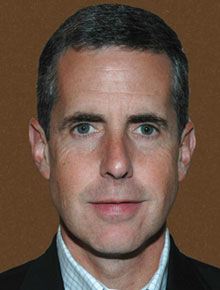The COVID-19 conversation centers mainly around the impact government-mandated shutdowns continue to have on restaurants. At the same time, however, individual members of the supply chain that support restaurants and other foodservice operators continue to deal with unique and challenging circumstances.
 Rob ConnellyTo get a better idea as to how foodservice equipment and supplies manufacturers are holding up, we caught up with Rob Connelly, president of the North American Association of Food Equipment Manufacturers and CEO of Henny Penny Corp.
Rob ConnellyTo get a better idea as to how foodservice equipment and supplies manufacturers are holding up, we caught up with Rob Connelly, president of the North American Association of Food Equipment Manufacturers and CEO of Henny Penny Corp.
Q: A lot of the talk around the pandemic rightfully focuses on the impact of opening and closing restaurants to slow the spread of the virus. But COVID-19 - related guidelines impact factories, too. How are NAFEM members holding up?
A: Generally, I think pretty good. Better than they thought they might have be in April. NAFEM has such a diverse group of members, though, that it becomes difficult to generalize how everyone is doing. Many have stabilized and feel they are not in jeopardy of survival. They have figured out how to operate in this environment. Some are at 50% capacity and some are at a nearly 100% run rate.
Q: How do manufacturers feel about the coming year?
A: In this pandemic, pretty much everyone was deeply affected. It was an unprecedented drop in business. Some companies were at 20% of their typical business in April. That’s not just a downturn. Most had layoffs, furloughs and compensation cuts. Many are not back to where they were, but they have stabilized and are trying to get through to the other side. Now they are just trying to understand when this will get better. A big chunk feels like 2021 will be their path back to 2019 business levels or somewhere close to that. I would add, almost everyone I have talked to feels challenged trying to predict the future and project their numbers. That’s always a difficult thing but it’s even more complicated now. In April we had no idea how the year was going to finish out. As we progress, though, we are starting to feel better about what next year will be like. If you compare it to the restaurants with many closing and never coming back, we’ve heard very little of that with manufacturers. Everyone I know believes it will come back. Hospitality is just a part of who we are.
Q: How has the way manufacturers work with operators, dealers and consultants changed during the pandemic? Previously, this was a face to face industry but that’s kind of challenging at the moment.
A: For us and other manufacturers, working with existing customers has been fine. We use video conferencing and other tools. In fact, some of the meetings with top customers have probably gotten together more quickly because of this approach. And I’ve heard that from others. Where it becomes a little more challenging is prospecting for new customers. That’s harder for the manufacturers, the reps – anybody really. Video conferencing is a good tool but it’s harder to get to know someone through it.
Q: What are some steps manufacturers will take to provide a safe working environment for employees?
A: Most had to figure out how to efficiently take everyone’s temperature each day. Mask wearing is mandatory. It’s like wearing safety glasses. There’s no debating this. We socially distanced our production operations and put in plexiglass where appropriate. And we are cleaning all the time. Cleaning is a constant process. We still have our office folks working remote and our philosophy is if we can have fewer people on campus it’s safer for those who are on campus. We have lots of gloves, hand sanitizer and more. Some of this might vary on a state by state basis, too. But the goal for all of us as manufacturers is when you are at work it’s safer than anywhere else.
Q: Since the start of the pandemic, NAFEM has hosted weekly member webcasts. What’s been the reaction to these calls?
A: It’s been very positive. Deirdre Flynn (NAFEM executive vice president) and our headquarters team have created a lighthouse that provides a beacon of stability for our members. It creates a new, closer community for our members. The engagement has been unbelievable. Just to be there with others who are going through these things at the same time is important. Trying to explain PPP and other things that are happening – it’s really been helpful and appreciated. And we’ve had sessions with the leaders of other associations, like MAFSI, CFESA and FCSI, that’s really been powerful. Hopefully, it brings a little more empathy for each channel of the industry by spending time talking together. It’s brought people together in a positive way.
Q: What excites you about the future of the foodservice industry?
A: It’s an industry with awesome people and we all appreciate the food and drink aspects of hospitality. So the comeback will be all the sweeter. It’s not that we did not appreciate our ability to be face to face and enjoy a good meal together, but this experience will have us appreciating it all the more.




